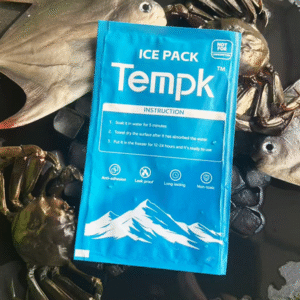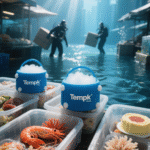Was sind die maximal zulässigen Mengen an Trockeneis pro Packung?? Ein vollständiger Leitfaden
Shipping dry ice requires understanding the rules governing its transportation to ensure safety and compliance. Trockeneis, oder festes CO2, ist für den Versand temperaturempfindlicher Güter von entscheidender Bedeutung, Aufgrund seiner Gefährlichkeit sind jedoch strenge Vorschriften darüber erforderlich, wie viel pro Paket versendet werden darf. In 2025, Diese Grenzwerte variieren je nach Transportart. In diesem Leitfaden erfahren Sie, welche Höchstmengen zulässig sind, Verpackungsanforderungen, und mehr.
-
Beschränkungen des Luftverkehrs: 2.5 kg für Passagierflüge, 200 kg für Frachtflüge.
-
Bodentransport: Bis zu 200 kg, mit weniger Einschränkungen bei Belüftung und Verpackung.
-
Internationale Sendungen: Je nach Land unterschiedlich; always check the destination’s regulations.
-
Verpackungsanforderungen: Die Belüftung ist entscheidend, um die Ansammlung von CO₂ zu verhindern.
Was sind die Höchstgrenzen für Trockeneis im Luftverkehr??
Air Transport and Dry Ice Regulations
Für Lufttransport, strict regulations control the amount of dry ice per package due to the risks associated with CO₂ gas buildup in confined spaces.
-
Passenger Flights: Maximal 2.5 kg (5.5 lb) pro Paket.
-
Cargo Flights: Allowed up to 200 kg (440 lb), though this can vary depending on the airline.
These limits are imposed to prevent asphyxiation risks from the sublimation of dry ice, wodurch CO₂-Gas freigesetzt wird. Airlines and cargo carriers require packages to be vented and clearly labeled with the weight and “Trockeneis” Gefahrensymbol.
Schlüsseleinsicht: Always check with your airline or freight provider, as additional restrictions might apply depending on the aircraft type.
Verpackungsanforderungen
Dry ice packages must allow gas to escape to prevent pressure buildup. The packaging must be entlüftet, and it should be labeled with “Trockeneis,” the net weight, and the hazard symbol “UND 1845”. Airlines typically reject unvented packages due to safety concerns.
| Shipping Mode | Max Trockeneis | Verpackungsanforderungen | Warum ist es wichtig |
|---|---|---|---|
| Passenger Flights | 2.5 kg | Belüftete Behälter, beschriftet “Trockeneis” | Sicherheit, asphyxiation risk prevention |
| Cargo Flights | 200 kg | Entlüftet, beschriftet, proper documentation | Größere Räume, kontrollierte Umgebungen |
| Bodentransport | 200 kg | Entlüftungsverpackung, Gefahrenhinweise | Reduces CO₂ buildup risk in confined spaces |
| Internationale Sendungen | Variiert | Check country-specific regulations | Compliance with local laws and regulations |
How Much Dry Ice Can You Ship by Ground and Sea Transport?
Ground Transport Regulations
Für Bodenversand, such as personal or commercial vehicles, the regulations are more relaxed than for air transport. Nach dem Verkehrsministerium (PUNKT), you can ship up to 200 kg pro Paket. Jedoch, adequate ventilation is still necessary.
Sea Transport Regulations
Sea freight often mirrors air transport regulations, especially under the International Maritime Dangerous Goods (IMDG) Code. Packages can be larger, but proper labeling, Entlüftung, and documentation are still required to prevent CO₂ hazards during longer transit periods.
Special Considerations for Trockeneisschifffahrt
Internationale Sendungen
Beim Versand international, it’s essential to be aware of the varying regulations across different countries. Some regions may have stricter limits or specific documentation requirements, so always consult with your carrier before shipping internationally.
Exceptions and Special Provisions
Certain exceptions exist for larger quantities of dry ice under special circumstances. Zum Beispiel, cargo aircraft may accept more than 200 kg per package if the shipment is properly packaged and labeled according to specific regulations.
How to Safely Package Dry Ice
Proper Verpackung of dry ice is crucial to avoid accidents such as container ruptures due to CO₂ pressure buildup. Always use sturdy, leak-proof containers with vent holes or cracked lids.
Verpackungscheckliste:
-
Behälter: Use rigid boxes made from fiberboard, Plastik, or wood.
-
Belüftung: Ensure the container allows CO₂ gas to escape.
-
Isolierung: Use foam, but leave gaps for gas release to prevent airtight seals.
-
Beschriftung: Clearly mark the package with “Trockeneis” and include the weight and hazard labels.
FAQ: Common Dry Ice Shipping Questions
Q1: Wie viel Trockeneis kann ich im Flugzeug mitnehmen??
Passengers can carry 2.5 kg (5.5 lb) of dry ice in checked or carry-on luggage, with the airline’s approval and proper venting.
Q2: Kann ich mehr versenden als 200 kg Trockeneis?
Ja, but you’ll need special provisions, like larger cargo shipments with prior carrier approval. Check with the carrier for compliance.
Q3: What happens if I exceed the dry ice limits?
Exceeding the limits can lead to delays, Geldstrafen, or rejection of the shipment by the carrier. Always verify the limits with your transport provider.
Abschluss: Key Takeaways
Shipping dry ice requires strict adherence to regulatory limits to ensure safety. Whether you’re transporting by air, Boden, oder Meer, understanding and complying with the maximum dry ice quantities per package is vital to avoid penalties. Verwenden Sie immer entlüftete Verpackungen, Stellen Sie eine ordnungsgemäße Kennzeichnung sicher, and check the latest regulations.
Umsetzbarer Rat: Ready to ship safely? Contact us for expert advice on packaging, Einhaltung, and choosing the right transport mode for your dry ice shipments.
Über Tempk
Tempk is a leader in cold-chain logistics, providing innovative packaging solutions and regulatory compliance support for dry ice shipping. Our team ensures your temperature-sensitive shipments comply with all transport regulations.
























